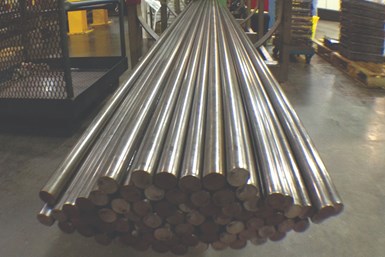Cold-Drawn Steel Barstock: How It Is Manufactured, Benefits to Your Shop
Understanding the benefits provided by cold-drawn steel barstock can help you optimize the work you quote by maximizing benefits to your manufacturing process and customer.
How Are Steel Bars Cold Drawn?
Hot-rolled steel bars, either in cut lengths or in coils, are first cleaned by shot blasting or acid pickling to remove the hard abrasive oxide scale on the surface. Then they are pulled through a carbide die in the presence of high-pressure lubricants which reduces the bar’s cross section. This process is called cold work (no heat is added in the process). The cold work trues up shape and holds diameter size to a very tight tolerance. The process also improves strength (increasing both yield and tensile strength) and hardness while reducing ductility (% elongation and % reduction in area). The drawn bar is then straightened and cut to length, followed by further testing for surface imperfections, if specified. Bars then have rust preventive applied and are packaged and labeled for shipment.
Why Cold-Drawn Steel Bars?
The process of cold drawing is done at ambient temperatures and transforms the material properties by a process called cold work. This cold work increases yield strength substantially; the tensile strength somewhat; as well as the hardness. At the same time, the ductility is reduced, which improves the steel’s machinability. Because the cold drawing work is done at ambient temperatures, the tolerance achieved for size and out-of-round is held to just a few thousandths of an inch.
By convention, tolerances are held to the minus, nothing to the plus. This makes loading into workholding more convenient, and the material diameter and shape are often useable as is for many mechanical components.
Specifications for Cold Drawn Carbon and Alloy Steel Bars
Cold drawn carbon and alloy steel bars are specified in ASTM A 108 Steel Bar, Carbon and Alloy, Cold-Finished. Size tolerances for Level 1 Carbon Steel Cold-Finished Round Bars (Cold Drawn, or Turned and Polished) can be found in Table A1.1 of ASTM A108. For alloy grades, the size tolerances are found in Table A1.2. Tolerances are based on bar diameter, and carbon content and thermal treatment
The reasons to select a cold-drawn steel bar are few but compelling:
- The hard abrasive scale has been removed — preserving tool life as well as metalworking fluid utility. The cold drawing operation improves the as-received surface finish of the bar.
- The cold-working strain imparted by cold drawing improves the machinability of the material (not only the ease of removal of chip but also the resulting surface finish.)
- The tight dimensional and out-of-round tolerance may result in a reduction in processing needed.
- The straightness (lack of runout) as well as the better concentricity and dimensional tolerance enables higher rpms. The higher surface feet per minute increases output.
- The higher mechanical properties mean that the part may withstand higher stresses and forces in the customer’s application. This makes cold-drawn steel bars ideal for shafting and power transmission applications.
- Standard grades are widely stocked and available for prompt delivery.
While the cold-drawn bar as shipped has a bright, smooth, workmanlike surface (since no stock removal was taken), it is not warranted for surface finish. However, the bright drawn finish is often suitable without any additional processing. Typically, surface finish is in the neighborhood of 125- 32 microinches using normal processes. (Machinery’s Hand-book) However, many of today’s mills have specialized processes that can deliver better.
What don’t you get with cold drawing? As no stock removal has been taken, there is still the possibility of seams and other surface imperfections. This possibility increases when the steel is resulfurized. While the sulfur promotes better machining, it also increases the possibility of seams and other surface imperfections.
ASTM A 108 table A1.8 provides the surface discontinuity tolerances for carbon and alloy bars, based on sulfur content and bar diameter.
Material may be in stock available for prompt delivery. Finally, a less important but often overlooked factor is that cold-drawn steel bars are the most widely used feedstock in most of our precision machining shops. As a standard raw material, produced to standards for chemistry and tolerances, our shops are able to gain experience and understand what to expect when ordering cold-drawn bars.
Cold-drawn steel bars cost more than hot-rolled steel bars of the same grade, due to cost of manufacturing as well as yield loss in the manufacturing process. However, the benefits afforded to our precision machining shops are the absence of hard abrasive oxide scale, improved mechanical properties which lead to better machinability, improved dimensional control, concentricity, surface finish and straightness.
It is easy to see the benefits of using cold-drawn steel bars outweigh their increased cost of production. Careful handling will preserve surface finish and straightness, minimizing perishability of quality. It is no accident that cold-drawn steel bars are a preferred material for many precision machined components. Now you know some of the reasons why.
Read More Articles from PMPA:
- The Battle for Performance: Efficiency Versus Effectiveness
- Craftsman Cribsheet No.116: Twist Drills for Success
About the Author
Miles Free III
Miles Free III is the PMPA Director of Industry Affairs with over 40 years of experience in the areas of manufacturing, quality, and steelmaking. He helps answer “How?, “With what?” and “Really?” Miles’ blog is at pmpaspeakingofprecision.com; email – mfree@pmpa.org; website – pmpa.org
Related Content
A No/Low-Cost Solution to Employee Retention
Studies show a little employee recognition goes a long way. Here are the 5Ws to consider for success.
Read MoreCraftsman Cribsheet No. 129: How to Beat the Heat
Shops tend to heat up in the summer. Here are some tips for staying cool in the warmer months.
Read MoreRoles of Women in Manufacturing: What I Learned
Over 20 women were featured in the Roles of Women in Manufacturing series, which started in January 2023.
Read MoreOnshoring Weather Report: Strong Tailwinds!
Onshoring, reshoring, nearshoring: these terms are showing up with increasing frequency in the news and online. But is there evidence that these are real?
Read MoreRead Next
5 Aspects of PMTS I Appreciate
The three-day edition of the 2025 Precision Machining Technology Show kicks off at the start of April. I’ll be there, and here are some reasons why.
Read MoreA Tooling Workshop Worth a Visit
Marubeni Citizen-Cincom’s tooling and accessory workshop offers a chance to learn more about ancillary devices that can boost machining efficiency and capability.
Read MoreEmerging Leaders Nominations Now Open
Here’s your chance to highlight a young person in your manufacturing business who is on the path to be a future leader moving your company forward.
Read More











.png;maxWidth=300;quality=90)











